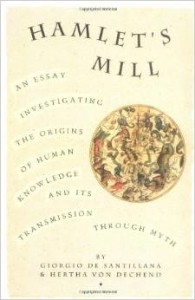 I’ve just finished re-reading Hamlet’s Mill, for the fourth time. That makes it the third-most-reread book in my library, I think, and the most-reread work of scholarly nonfiction.
I’ve just finished re-reading Hamlet’s Mill, for the fourth time. That makes it the third-most-reread book in my library, I think, and the most-reread work of scholarly nonfiction.
Hamlet’s Mill is about mythology. The authors argue that myth, and its degraded successors folk tale and fable, encode ancient technical astronomical data. This information was handed down in story form because its codification preceded literacy. The nature of myth then effectively embedded the astronomy deep into a kind of code, which could pass unnoticed before the eyes of the uninitiated and even be handed down by multiple ignorant generations seriatim before reaching a sympathetic ear. De Santillana and von Dechend start with the familiar figure of Hamlet, but before they’re done they’ve danced with Samson, Kronos, Susanowo, Pan, Vishnu, Tlaloc, Phaethon, Tammuz, Ptah, Gilgamesh, and many, many others.
Hamlet’s Mill is a must-read for your personal education. Until the twentieth century, humans lived inside a sphere surrounded by an eternal round of stars. What did those humans before us see? Did they really think the earth was flat? What did they think when they discovered that the apparently unchanging procession could slip, the throne of the celestial kingdom passing from one constellation to another? What did they mean when they talked about heroes like Gilgamesh diving to the bottom of the ocean to retrieve gifts that brought with them immortality?
And because this is a website that has to do with writing — how deep are the mythologies of your worlds? Do they tie to liturgy? Fertility rites? Sympathetic magic? The motion of the planets?

 Follow
Follow





































